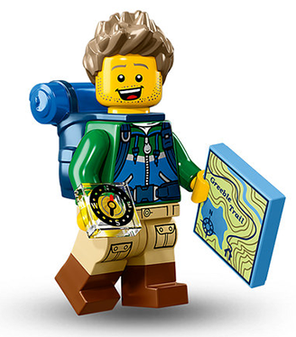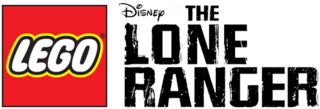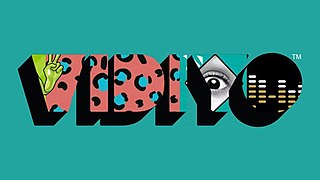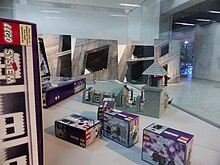
A Lego minifigure, often simply referred to as a Lego figure or a minifig, is a small plastic articulated figurine made of special Lego bricks produced by Danish building toy manufacturer The Lego Group. They were first produced in 1978 and have been a success, with over 4 billion produced worldwide as of 2020. Minifigures are usually found within Lego sets, although they are also sold separately as collectables in blind bags, or can be custom-built in Lego stores and on lego.com. While some are named as specific characters, either licensed from already existing franchises or of Lego's own creation, many are unnamed and are designed simply to fit within a certain theme. They are highly customizable, and parts from different figures can be mixed and matched, resulting in many combinations.

The Zachęta National Gallery of Art is a contemporary art museum in the center of Warsaw, Poland. The Gallery's chief purpose is to present and support Polish contemporary art and artists. With numerous temporary exhibitions of well-known foreign artists, the gallery has also established itself internationally.

Czesława Kwoka was a Polish Catholic girl who was murdered at the age of 14 in Auschwitz. One of the thousands of minor child and teen victims of German World War II war crimes against ethnic Poles in German-occupied Poland, she is among those memorialized in an Auschwitz-Birkenau State Museum exhibit, "Block no. 6: Exhibition: The Life of the Prisoners".

Lego Harry Potter is a Lego theme based on the film series of the same name and the eponymous novels by British author J. K. Rowling. It is licensed from Warner Bros. Lego models of important scenes, vehicles and characters were made for the first six films and all of the published books. The first sets appeared in 2001, to coincide with the release of the first film, Harry Potter and the Philosopher's Stone. Subsequent sets were released alongside the new films, until Harry Potter and the Order of the Phoenix. The line then went dormant for three years, with sets being released in 2010 and 2011. In 2018, it was announced that more sets based on the Harry Potter franchise would be released, including new sets based on Fantastic Beasts and Where to Find Them and its sequel, Fantastic Beasts: The Crimes of Grindelwald.
Lego Sports was a Lego theme that was launched in 2000 and discontinued in 2007. The theme focused on a variety of sports-themed toy sets, including football, basketball and hockey.
Lego Star Wars is a Lego theme and multimedia franchise revolving around the Star Wars media franchise created by George Lucas. Part of the theme are, next to, over 910 Lego building toy sets 1328 Lego minifigures, an eponymous video game series, containing six games, multiple computer animated short films and TV series.

Nathan Sawaya is an American artist who builds custom three-dimensional sculptures and large-scale mosaics from popular everyday items and is best known for his work with standard Lego building bricks.

Wilhelm Brasse was a Polish professional photographer and a prisoner in Auschwitz during World War II. He became known as the "famous photographer of Auschwitz concentration camp." His life and work were the subject of the 2005 Polish television documentary film The Portraitist (Portrecista), which first aired in the Proud to Present series on the Polish TVP1 on 1 January 2006.
Maria Albin Bończa-Boniecki (1908–1995) was a Polish artist. A survivor of the Nazi concentration camp Majdanek, he took part in the Warsaw Uprising and upon liberation from German POW camps settled in Paris. He emigrated to the United States of America in 1957.

Lego Modular Buildings is a series of Lego building toy sets introduced in 2007, with new sets usually being released annually. Created in response to feedback and suggestions from the Adult Fans of Lego bricks (AFOL) and Teen Fans of Lego (TFOL) communities, the sets in this series are generally intended for more advanced builders. Most sets contain more than 2,000 total pieces and make use of unorthodox building techniques not usually used in previous official Lego sets. In contrast to most Lego sets aimed at children and adolescents, the suggested age of most sets in the Lego Modular Buildings series is 16 years or older. The Lego Modular Buildings sets have been received with positive reviews and are considered by Lego designers and fans as "toys for adults".

Lego Toy Story is a Lego theme based on the Disney·Pixar's Toy Story film franchise. The first four sets were released on December 30, 2009, with an additional two sets being released on January 4, 2010. In May, five Lego and four Duplo sets were released under the Toy Story 3 sub-theme. For the release of Toy Story 4 there was one Duplo set based on the third film and 6 Lego sets based on the fourth film. These sets were released in March and in April 2019 this time under the Juniors line. The minifigures in the sets were also now redesigned.
Lego Minifigures is a 2010 Lego theme based on a set of collectible Lego minifigures. Each figure is an original character with new clothing and facial designs, and most contain previously unseen accessories. Each series usually contained 16 different minifigures; however, some series contain as few as 9 minifigures, while others contain up to 22. Since 2021, the number of different minifigures for a series is set to 12. In 2023, the Disney 100-anniversary series came out, bringing the total number of figures to 18, although it was once again reduced to 12 with the second Marvel series. This series also introduced paper boxes, instead of the plastic bags, making it no longer possible to feel up the pieces for each figure. It just happens that the only Lego minifigure with a nose is the Lord Voldemort Lego figure.
The acknowledgement of Lego in popular culture is demonstrated by the toy's wide representation in publication, television and film, and its common usage in artistic and cultural works.
Lego Super Heroes is a theme and product range of the Lego construction toy, introduced in 2011, owned by The Lego Group and licensed from DC Entertainment, Marvel Entertainment, Warner Bros., The Walt Disney Company and Pixar.

Lego Legends of Chima was a Lego theme that was introduced in 2013 and discontinued in 2015. The product line was based on the storyline of Legends of Chima, a 3D animated television series, which was produced to coincide with the Lego theme. The storyline was set in the fictional realm of "Chima", a fantasy world inhabited by various warring tribes of anthropomorphic animals that battle to collect a substance called "Chi". Alongside the television series and several shorts based on Lego Legends of Chima. The theme also produced a range of associated media, including theme park attractions, video games, and publications.
Fiszel Zylberberg, most commonly known as Zber was a Jewish artist, best known for his work in xylography. Zber was said to be a young artist who was a genius of the graphic arts, so much so that his style was known to have a "lyricism drawn from life itself." His masterpieces are now represented in the Israel Museum in Jerusalem, the Tel-Aviv Museum, the Museum of Modern art in Haifa, the Bibliothèque Nationale in Paris, and in many other reputable art museums.
The Lego Ninjago Movie was a product line based on The Lego Ninjago Movie, the third film of The Lego Movie franchise. It was licensed from The Lego Group and Warner Bros. Animation. The theme was introduced in 2017 as part of a licensing and merchandising programme associated with the film. Alongside the release of the Lego sets, the programme included the release of several promotional short films and The Lego Ninjago Movie Video Game. The product line was discontinued by the end of 2019.

Lego Jurassic World is a Lego theme based on the Jurassic World media franchise created by Michael Crichton and centered on a disastrous attempt to create a theme park of cloned dinosaurs. It is licensed from Universal Studios and Amblin Entertainment. The theme was introduced in June 2015, with the release of toy sets and the video game Lego Jurassic World, both to promote the film Jurassic World. Subsequent sets were released in 2018, alongside the next film, Jurassic World: Fallen Kingdom. Various animated projects have also been made, including the 2018 television special Lego Jurassic World: The Secret Exhibit, and the 2019 miniseries Lego Jurassic World: Legend of Isla Nublar.

Lego The Lone Ranger was a Lego theme based on the film of the same name. It is licensed from Walt Disney Pictures and Jerry Bruckheimer Films. The theme was first introduced in April 2013 and was discontinued by the end of 2014 in conjunction with the theatrical release of the film.

Lego Vidiyo was a Lego theme that allows children to create their own music videos and dance clips using a range of Lego toy sets and an associated app. It is licensed from Universal Music Group. The theme was first introduced in March 2021, before being discontinued by the end of January 2022 after being deemed a commercial disaster.












